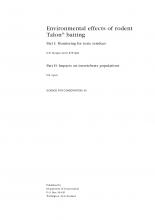UK Rodent Eradication Best Practice Toolkit

BRB
Available Online
The spread of invasive non-native species presents one of the greatest threats to biodiversity globally: invasive species are the primary driver of biodiversity loss on islands and the second largest everywhere else (CBD ; Millennium Ecosystem Assessment, 2005). Many of the UKs island ecosystems have been damaged by the arrival and establishment of invasive non-native species. Introduced predators have caused particularly catastrophic damage to many species of waders and seabirds, undoubtedly causing numerous extirpations as well as contributing to ongoing declines(Stanbury et al. 2017). Removing invasive vertebrates from islands is an important conservation tool to protect and restore island ecosystems and to prevent further declines and losses of native species. The UK Rodent Eradication Best Practice Toolkit is intended as an advisory resource, providing a systematic approach for planning and implementing rodent eradications and biosecurity in the UK. It provides technical advice on specific methods to be used in the UK, as well as an eradication project management framework which is applicable to projects everywhere. This Best Practice Toolkit has been compiled, and contributed to, by several UK governmental and non-governmental organisations involved in island restoration, these being: Royal Society for the Protection of Birds (RSPB), Animal and Plant Health Agency (APHA), Department for Environment, Food and Rural Affairs (Defra), GB Non-Native Species Secretariat (GB NNSS), Joint Nature Conservation Committee (JNCC), National Trust, National Trust for Scotland, Natural England, Natural Resources Wales (NRW), Scottish Natural Heritage (SNH), Scottish Wildlife Trust (SWT) and the Isles of Scilly Wildlife Trust. The Toolkit has also received input from Wildlife Management International Ltd (WMIL), and draws heavily from the documentation produced by WMIL for various rat eradication projects undertaken in the UK. The use of the UK Rodent Eradication Best Practice Toolkit aims to give UK organisations and practitioners the ability to embark on invasive rodent management projects with greater confidence of achieving the desired island restoration goals. For more information or to provide feedback on this resource, please contact Sophie Thomas
[email protected] .
